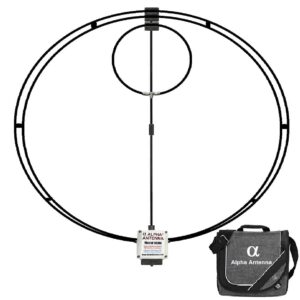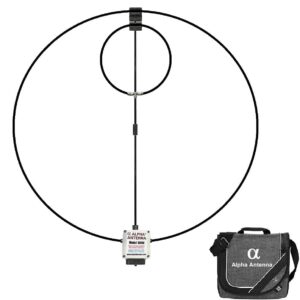A thorough look at the 10-80 Meter Alpha Magnetic Loop MagLoop Antenna
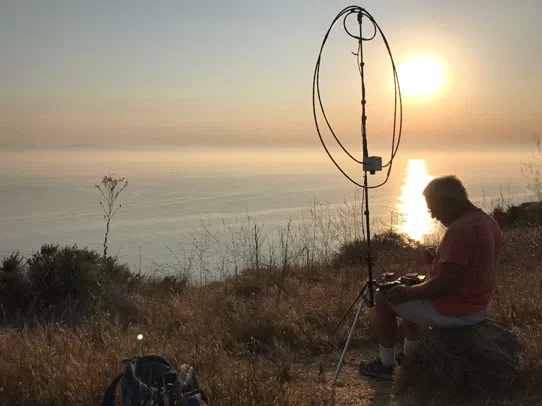
Experimentations, Observations, & Optimizations with the Alpha Magnetic Loop MagLoop
Obstructions will reflect your signal back at your antenna, which can cause higher (reflected) SWRs.
By – Rick N6IET
Introduction to the Alpha Loop
My Magnetic Loop MagLoop adventure with the Alpha Loop antenna began with a deployment on a Friday morning. This was a top a 350-foot seaside ridge facing Ventura on Santa Cruz Island. Based upon the failures and successes of that deployment, I began my journey. This is what I learned from my experiments, observation, and optimizations my Alpha Loop antenna.
Here, my photo with the Alpha Loop, Elecraft KX2, HF Packer Amp, and LiFePO4 battery

Improvements
The first improvement that I made were tripod leg extensions. I am using 2-foot lengths of aluminum tubing cut from a 6-foot tube I happened to have on hand. They slipped snugly over the original short legs and weighed practically nothing. I sat on that rock facing approximately northeast. You can see one of the ferry boats approaching Scorpion Anchorage off to the left.
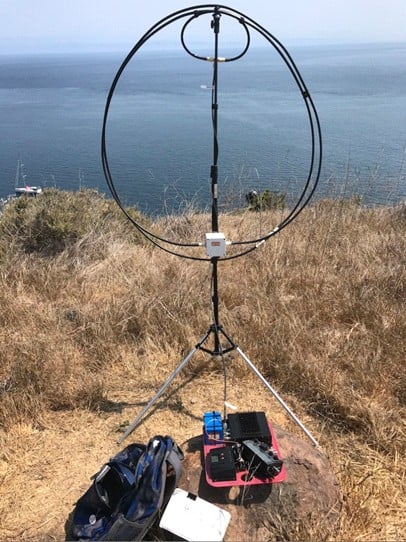
Alpha Loop (with 40-80M Booster Cable)
After my adventure to Santa Cruz Island, I began testing and experimenting with my Alpha Loop in my living room. Surprisingly, the loop tuning and SWR aren’t much affected by my living area (wooden floors and ceiling/roof). The lowest resonant frequency was 3416 kHz with an SWR of 1.1. This was with the tuning capacitor fully meshed and both loops at the same circumference. My highest resonant frequency (tuning capacitor fully unmeshed) of between 8000 and 8200 kHz. This was with the Booster Cable installed using any of my double-loop arrangements.
On 40-80 meters the Alpha Loop is 20 watts with the Booster Cable installed, per the manufacturer’s specifications. Deployment can be accomplished in approximately 5 to 10 minutes.
The Tuning Knob
I originally inverted the tuning box (moved the knob to the bottom & outside the loop). My hand on the tuning knob had more effect on the SWR while tuning after I moved the knob to the bottom & outside of the loop. So, after additional testing I moved this back to the way it came (knob on top instead of bottom). With the knob at to the top of the tuning box, my hand still has some effect on SWR. That was not as much effect as when the knob is placed outside the Magnetic Loop MagLoop.
Clip & Loop Placement
Using the included clips, I spaced the inner exciter loop 7/20 inch from the outer radiator loop at the top. Placing Velcro straps at the 10 & 2-o’clock positions kept the two outer loops close together. At the 7:30 and 4:30 positions I used another pair of nylon clips. This was to stabilize the two loops diverge (when the booster loop is longer than the main loop). The relative circumferences of the two outer loops didn’t make much difference. With the exception that I could get an SWR of 1.0 on 80 meters by making the two loops the same circumference and routing the booster loop behind the mast and tuning box. Using my Comet antenna analyzer I got the following SWRs using the 40/60/80 Meter Booster Cable.
80m – 1.2
60m – 1.5
40m – 1.2
Tuning Tip
You can compensate for any variance in SWR by slightly in(de)creasing the capacitance to get it to drop back to minimum SWR when you withdraw your hand. Alpha Antenna calls this reverse tuning. The procedure for reverse tuning is this. “To compensate the effect of hand capacitance that might occur, a technique called reverse tuning can be used. To reverse tune a magnetic loop MagLoop, tune for minimum SWR; take note of the SWR while tuning and touching the Black Knob on the Alpha Match. Fpr example, say you observe and SWR of 1.9:1 while touching the knob. Then when you remove your hand you see and SWR of 4.3:1. Then all you have to do is tune for 4.3:1 while your hand is on the knob to achieve an SWR of 1.9:1 when you remove your hand.”
OPTION 1 – Best Results: Loops at the same circumference and booster loop behind mast & tuner.

OPTION 2 – Good compromise: Intermediate double loop arrangement.

OPTION 3 – Not good: Default loop unchanged and booster loop dropping a lot.
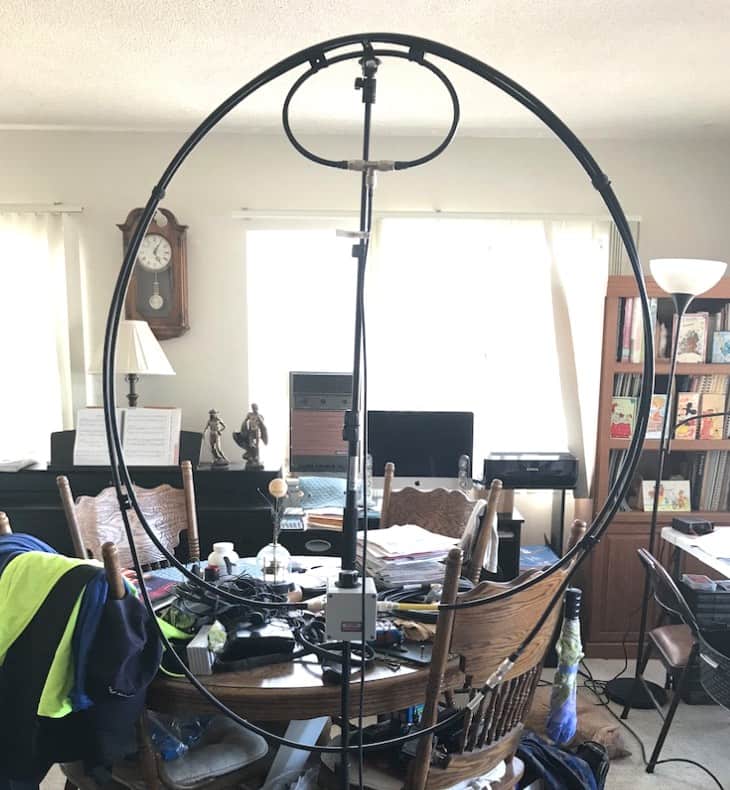
Loop is kept at the same circumference as a single loop, with booster loop drooping a lot (not good).
Alpha Loop (without Booster Cable installed)
The Alpha Antenna Loop without the Booster Cable installed is a 100 watt 10-40 meter antenna, per the manufacturer’s specifications. Deployment can be accomplished in approximately 5 minutes.
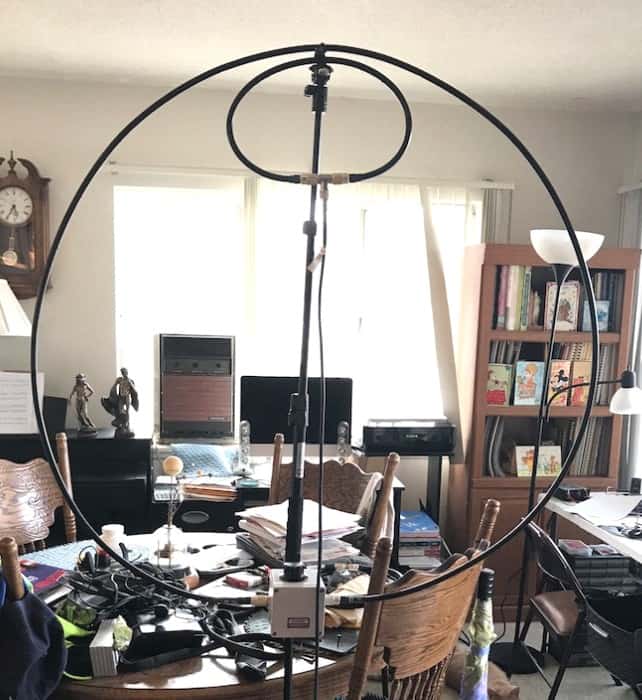
Shown with 3/8-inch spacing (outer loop directly above exciter loop).
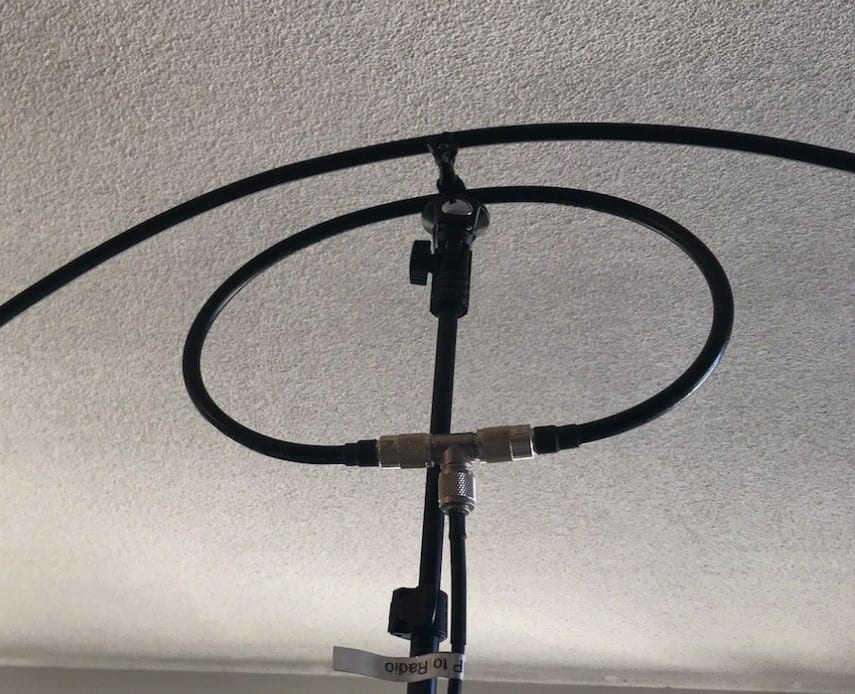
Showing the maximum one-inch spacing (done for testing).
Inner/Outer Loop Spacing – Using the single outer loop I experimented with the spacing between the exciter loop and the radiator (secondary) loop. Below are the SWRs on each band at 3/8, 7/20, 3/4 and 1-inch spacing, respectively. I used the included nylon spacers from Alpha for the 7/20″ spacing on the Magnetic Loop MagLoop.
Band 3/8″ 7/20″ 3/4″ 1″
40m 1.4 1.5 1.2 1.0
30m 2.0 2.0 1.5 1.3
20m 1.6 1.6 1.4 1.0
17m 1.2 1.3 1.0 1.0
15m 1.0 1.1 1.0 1.15
12m n/a 1.5 2.5 3.0
10m 1.5 1.3 2.6 3.0
Actually, it turns out that the 7/20-inch spacing that’s enforced by those nylon clips from Alpha work pretty well for the higher bands, and results in a SWR of 1.5 on 40 meters, 2.0 on 30 meters and 1.6 on 20 meters. As it turns out, 1” spacing worked better for bands below 17 meters, and well enough on 15 meters. Although one-inch spacing did not work well on 12 & 10 meters where an SWR of 3:1 was observed.
Reverse Beacon Network (RBN) results – Below are some RBN skimmer reports generated during my rooftop testing.

The Booster Cable
During usage, I found that my HF Packer Amp was ‘cutting out’ during my rooftop tests. This was in fact due to capacitor arcing and turning down the drive power (and therefore the output power) to between 64% (on 80 meters) and 84% (on 40 meters) avoided the problem. I don’t have accurate power output readings, but I estimate that full power (with 5-watt drive) results in about 50 watts out on 80m and about 40 watts out on 40m. If so, I was able to run up to about 32 watts CW on 80 thru 40 meters. So I think the 10-watt CW power limit (20-watt SSB PEP) from Alpha Antenna with the booster cable is far too conservative.
Radiation Pattern
Remember that a Magnetic Loop MagLoop (a small fraction of a wavelength in circumference) emphasizes the magnetic component and minimizes the electrical component of the near field. That’s because of the high current in the loop (enabled by the milli-ohms of radiation resistance) and the close spacing between the high-voltage points across the (physically and electrically small gap) of the series capacitor. In the far field, the two fields equalize in strength, forming a standard electromagnetic wave.
The radiation pattern in free space is a donut pattern aligned with the loop itself, and when mounted vertically is a figure-8 pattern in the direction of the vertical plane of the loop. The angle of radiation in that case is from horizon through the zenith to horizon, so you can take advantage of both NVIS and the MUF. Its polarization is mostly vertical. If you mount it horizontally, the rules of height above ground w.r.t. angle of radiation and ground losses apply, so the higher the better up to 1/4 wavelength (NVIS) or 1/2 wavelength (MUF toward horizon) above ground. Those living high above the ground in condos or apartments with balconies might be able to fashion a fairly effective horizontal mag loop sticking out a few meters from the stucco walls of our buildings.
Reflections
As I reflect back on my 72-hour island campout (with 4 other hams), I had worked Don ND6T (using a QCX QRP rig) in Weaverville, JB NR5NN in Benicia, Bob KJ6CA near Sacramento, Mitch KB6FPW/p (K2 at 10 watts) from a campground NE of Fresno, and the Bob Net on 80 meters on Friday morning – pretty amazing for a 3-foot diameter Magnetic Loop MagLoop on 80 meters! I also checked into the PARG net on 7034 kHz and then worked Mark K6JJR (near Sacramento), George N0FU (Chula Vista), and Pete AA6ZE (Santa Rosa) on 40 meters. With my new found knowledge, I am sure to have even better adventures with the Alpha Loop and hope that you have found this information useful.
Rick N6IET
N6IET – Callsign Lookup by QRZ Ham Radio
Magnetic Loop Antennas Magloops – Alpha Antenna
For tips on using the MagLoop CLICK HERE
-
Sale Product on sale10-80M 100W* MagLoop (**6M/VHF/UHF)
$600.00Original price was: $600.00.$550.00Current price is: $550.00.Rated 5.00 out of 5 based on 85 customer ratings -
Sale Product on sale10-40M 100W MagLoop (*6M/VHF/UHF)
$550.00Original price was: $550.00.$500.00Current price is: $500.00.Rated 5.00 out of 5 based on 79 customer ratings

